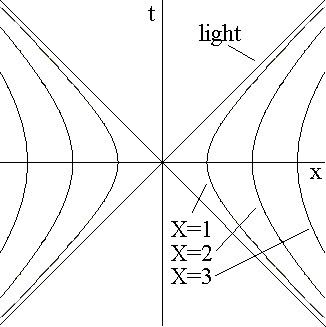Hyperbolic motion is the motion of an object with constant proper acceleration in special relativity. It is called hyperbolic motion because the equation describing the path of the object through spacetime is a hyperbola, as can be seen when graphed on a Minkowski diagram.
Regarding the historical development, Hermann Minkowski (1908) showed the relation between a point on a worldline and the magnitude of four-acceleration and a "curvature hyperbola" (German: Krümmungshyperbel). Max Born (1909) subsequently coined the term "hyperbolic motion" (German: Hyperbelbewegung) for the case of constant magnitude of four-acceleration, then provided a detailed description for charged particles in hyperbolic motion, and introduced the corresponding "hyperbolically accelerated reference system" (German: hyperbolisch beschleunigtes Bezugsystem). For early reviews see the textbooks by Max von Laue (1911, 1921) or Wolfgang Pauli (1921). See also Gourgoulhon (2013) and Acceleration (special relativity)#History.
The proper acceleration
α
of a particle is defined as the acceleration that a particle "feels" as it accelerates from one inertial reference frame to another. If the proper acceleration is directed parallel to the line of motion, it is related to the ordinary three-acceleration in special relativity
a
=
d
u
/
d
t
by
α
=
γ
3
a
=
1
(
1
−
u
2
/
c
2
)
3
/
2
d
u
d
t
,
where
u
is the instantaneous speed of the particle,
γ
the Lorentz factor,
c
is the speed of light, and
t
is time. Solving for the equation of motion gives the desired formulas, which can be expressed in terms of coordinate time
t
as well es proper time
τ
. For simplification, all initial values for time, location, and velocity can be set to 0, thus:
u
(
t
)
=
α
t
1
+
(
α
t
c
)
2
=
c
tanh
(
arsinh
α
t
c
)
x
(
t
)
=
c
2
α
(
1
+
(
α
t
c
)
2
−
1
)
=
c
2
α
(
cosh
(
arsinh
α
t
c
)
−
1
)
c
τ
(
t
)
=
c
2
α
ln
(
1
+
(
α
t
c
)
2
+
α
t
)
=
c
2
α
arsinh
α
t
c
u
(
τ
)
=
c
tanh
α
τ
c
x
(
τ
)
=
c
2
α
(
cosh
α
τ
c
−
1
)
c
t
(
τ
)
=
c
2
α
sinh
α
τ
c
The function
x
(
t
)
gives
x
2
−
c
2
t
2
=
c
4
/
α
2
,
which is a hyperbola in time and the spatial location variable
x
. If instead there are initial values different from zero, the formulas for hyperbolic motion assume the form:
u
(
t
)
=
u
0
γ
0
+
α
t
1
+
(
u
0
γ
0
+
α
t
c
)
2
=
c
tanh
(
arsinh
(
u
0
γ
0
+
α
t
c
)
)
x
(
t
)
=
x
0
+
c
2
α
(
1
+
(
u
0
γ
0
+
α
t
c
)
2
−
γ
0
)
=
x
0
+
c
2
α
(
cosh
(
arsinh
(
u
0
γ
0
+
α
t
c
)
)
−
γ
0
)
c
τ
(
t
)
=
c
τ
0
+
c
2
α
ln
(
c
2
+
(
u
0
γ
0
+
α
t
)
2
+
u
0
γ
0
+
α
t
(
c
+
u
0
)
γ
0
)
=
c
τ
0
+
c
2
α
(
arsinh
(
u
0
γ
0
+
α
t
c
)
−
artanh
(
u
0
c
)
)
u
(
τ
)
=
c
tanh
(
artanh
(
u
0
c
)
+
α
τ
c
)
x
(
τ
)
=
x
0
+
c
2
α
(
cosh
(
artanh
(
u
0
c
)
+
α
τ
c
)
−
γ
0
)
c
t
(
τ
)
=
c
t
0
+
c
2
α
(
sinh
(
artanh
(
u
0
c
)
+
α
τ
c
)
−
u
0
γ
0
c
)

